|
Report from
Europe
Slow growth in EU wooden furniture and joinery
sectors in 2017
There was only very slow growth in both the EU wood
furniture and joinery sectors during 2017. While
production and consumption gained momentum in parts of
continental Europe, particularly in Eastern Europe, this
was offset by a significant slowdown in the UK and stasis
in Germany.
Growth in the EU door sector was considerably more
buoyant than in the window and furniture sectors in 2017.
While wood made up some lost ground against plastics in
these sectors, market share was being lost to metal
products.
These are the main conclusions to be drawn from analysis
of newly released Eurostat PRODCOM data which
provides a snapshot of the production and consumption
value of wood furniture and joinery products in the EU in
2017.
No growth in wood furniture production in 2017
The value of EU wood furniture production was 40.3
billion in 2017, no change from the previous year and still
20% down on the level prevailing before the financial
crises in 2008.
A slowdown in production in the UK offset gains in
Poland, Spain, and Lithuania. Production in Italy and
Germany, the two largest manufacturing countries, and in
France and Romania was broadly flat in 2017 (Chart 1).
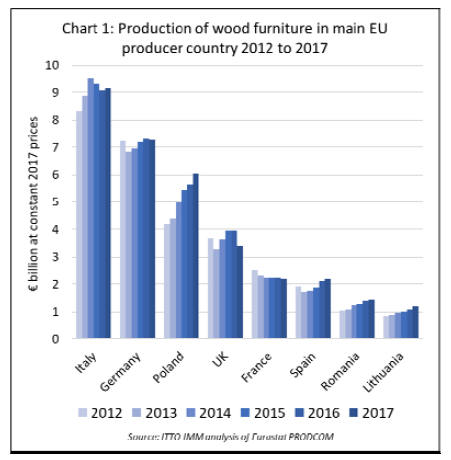
EU consumption of wood furniture was 37.6 billion in
2017, a gain of 2% compared to 2016. During 2017,
consumption was stable (at 9.4 billion) in Germany, the
largest market, and rising in Italy (+3% to 5.2 billion),
France (+1.5% to 4.3 billion), Spain (+7% to 2.2
billion), Netherlands (+30% to 1.5 billion), Poland
(+15% to 1.4 billion) and Sweden (+2.5% to 1.1
billion).
However, wood furniture consumption fell 6% to 6.5
billion in the UK and 5% to 870 million in Belgium
(Chart 2).
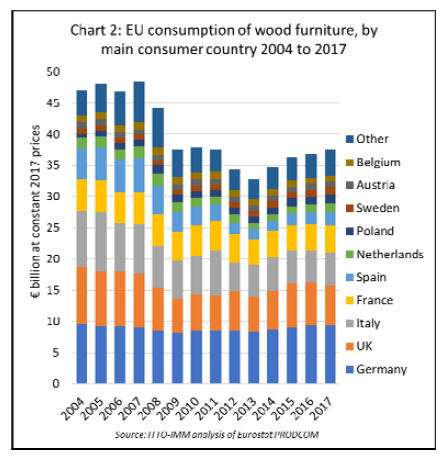
After flat lining in 2016, the value of EU imports of wood
furniture from non-EU countries increased 7% to 6.16
billion in 2017. Imports from China, by far the largest
external supplier fell 4% in 2016 but recovered 0.7% to
3.08 billion in 2017 (Chart 3).
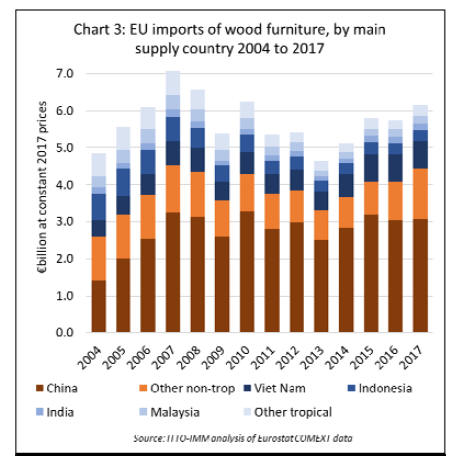
In recent years China‘―s competitiveness in the EU wood
furniture market has been impeded as prices have risen on
the back of growing domestic demand and new laws for
pollution control pollution in China.
EU furniture importers also continue to question the
variable quality of product imported from China and some
have struggled to obtain the legality assurances required
for EUTR conformance when dealing with complex wood
supply chains in China.
The main beneficiaries of rising EU wood furniture
imports in 2017 were other European countries including
Ukraine, up 67.7% to 133 million, Bosnia, up 14.9% to
218 million, and Serbia, up 13.7% to 127 million.
EU imports of wood furniture from tropical countries
increased 3.5% to 1.72 billion in 2017, reversing a 2.5%
decline the previous year.
Vietnam is the dominant supplier of furniture to the EU,
although imports were flat in 2016 and 2017 after rising
40% in the previous two years. Imports from Vietnam
declined 0.7% in 2016 and then increased just 0.5% to
724 million in 2017.
EU imports of wood furniture from Indonesia increased
2% to 309 million in 2017, following a 6% decline the
previous year. Imports from Malaysia increased 11% to
180 million, EU imports from Malaysia recovered by
10.7% to reach 203 million last year. Imports from
Thailand fell 3.4% to 61 million.
Recent survey work undertaken by the ITT0-IMM in
highlights that, to some extent, direct competition between
furniture suppliers in the various South East Asian
countries is limited by market differentiation.
With the rapid decline of availability of natural forest teak
from Myanmar, Indonesia is now best placed to supply a
wide range of outdoor furniture products, particularly due
to relatively abundant plantation teak supplies.
Indonesia's long woodworking tradition has also meant it
has gained a reputation for supply of good quality
specialist hand-made furniture, a niche market in the EU
where it competes most directly with India.
By contrast, the Vietnamese furniture sector has gained a
reputation for supply of large volume mid-range products,
both for exteriors and, increasingly, for interior use, and is
importing a wide range of wood from around the world to
feed this production.
The Vietnamese furniture industry is regarded by EU
importers as technically more evolved than most other
Asian producer countries and increasingly able to supply
products to high European quality standards.
Malaysia also supplies high quality products but offers a
much smaller range than Vietnam with a heavy focus on
rubberwood and other plantation species.
While these various external suppliers now play an
important role in specific sections of the EU furniture
market, the domestic industry remains very dominant. The
share of domestic manufacturers in total EU furniture
supply declined only slightly between 2013 and 2017.
In 2017, domestic manufacturers accounted for 86.7% of
the total value of wood furniture supplied into the EU
market, down from 87.5% in 2016 and 88.6% five years
before.
5% growth in wood door supply to the EU in 2017
Eurostat PRODCOM data reveals that the total value of
wood doors supplied to the EU increased by 5% to 7.12
billion in 2017. Despite the increase, the value of wood
doors supplied to the EU in 2017 was still more than 25%
down on the level prevailing before the global financial
crises (Chart 4).
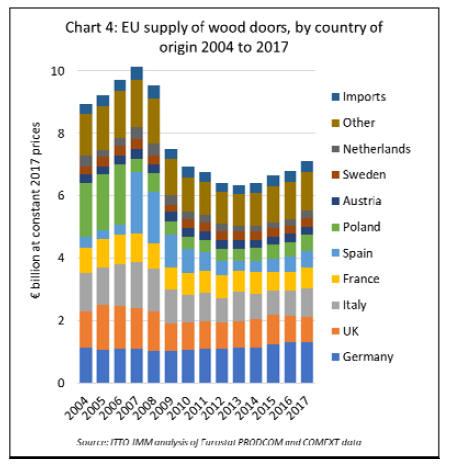
Most new wood door installations in the EU comprise
domestically manufactured products. The EU‘―s domestic
production increased 4.9% to 6.78 billion in 2017. There
was significant variation in the performance of the wood
door sector in EU countries in 2017.
Production in Germany, the largest wood door
manufacturing country, was stable at 1.30 billion during
the year while production in the UK continued to slide, by
2% to 840 million.
However, production increased sharply in Italy (rising
12% to 910 million), France (rising 5% to 640 million),
Spain (rising 14% to 540 million), Poland (rising 10% to
510 million) and the Netherlands (rising 30% to 250
million) (Chart 5).
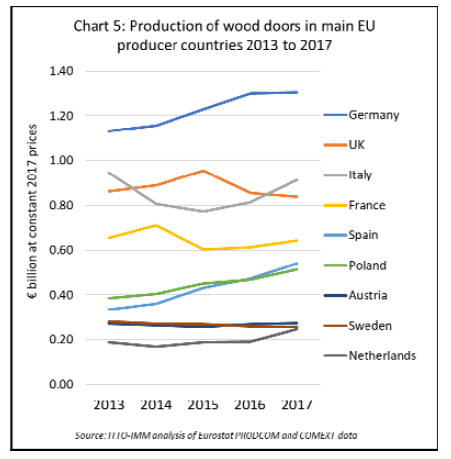
Wood door imports into the EU increased by just 0.3% to
341 million in 2017. Imports accounted for 4.8% of the
total euro value of wood door supply to the EU in 2017,
down from 5.0% the previous year.
Most of the gains in EU door imports in 2017 were from
other temperate countries including Norway (+7% to 16
million), South Africa (+16% to 12 million), Bosnia
(+29% to 7 million) and Ukraine (+50% to 7 million).
Imports from UAE, becoming more important as a wood
processing hub, increased from negligible levels to 5.4
million.
However, imports from China, the largest external
supplier, fell 2% to 111 million in 2017.
The total value of EU imports of wood doors from the
tropics fell 6% to 159 million in 2017. This was mainly
due to a decline in imports from Malaysia (-9% to 38
million) and Brazil (-19% to 13 million). The value EU
wood door imports from Indonesia also fell, but by only
3.8% to 102 million in 2017.
The European wood door industry is now dominated by
products manufactured using engineered timber driven by
requirements to comply with higher energy efficiency
standards and efforts to provide customers with more
stable products and long-life time guarantees.
Another key trend is towards composite doors with a steelreinforced
uPVC outer frame with an inner frame
combining hardwood and other insulation material.
These new products are designed to combine strength,
security, durability, high energy efficiency, with a strong
aesthetic.
There may be a place for tropical hardwoods in the design
of these products with manufacturers looking to combine
high quality, consistent performance, regular availability,
and good environmental credentials with a competitive
price.
EU market for wood windows flat in 2017
There was little growth in the market for wood windows in
the EU in 2017. The total value of wood windows supplied
to the EU increased only 0.7% to 6.07 billion in 2017
following a 2.8% decline the previous year (Chart 6).
The supply of wood windows to the EU is
overwhelmingly dominated by domestic production which
increased 0.7% to 6.07 billion in 2017. Imports from
outside the EU accounted for only 0.5% of total EU wood
window supply in 2017.
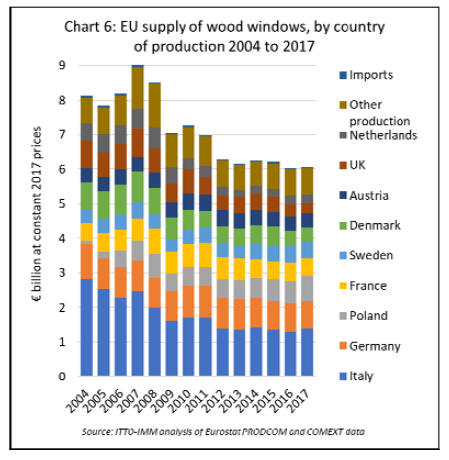
Italy has maintained its position as the largest window
manufacturer in the EU, with production rising around
7.2% to 1.39 billion in 2017. Production in Poland
continued to rise during the year, by 7% to 704 billion.
In contrast, wood window production in most large
western European markets declined in 2017, including
Germany (-1% to 802 million), France (-1% to 525
million), Sweden (-5% to 420 million), UK (-12% to
299 million) and the Netherlands (-4% to 254 million)
(Chart 7).
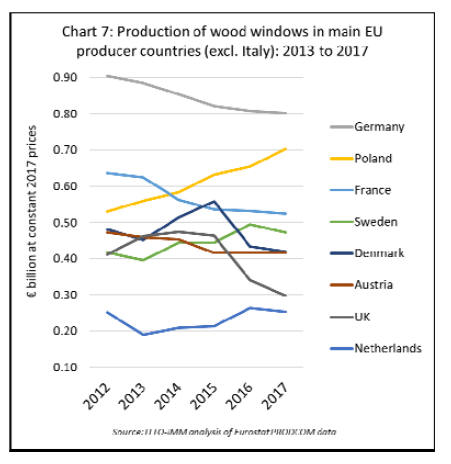
Imports of wood windows from outside the EU fell by
5.3% in 2017 to 31.4 million, continuing the downward
trend of the previous year. EU imports of wood windows
derive mainly from neighbouring European countries,
including Norway, Bosnia and Switzerland.
Only a very limited, and highly variable, quantity of wood
windows is imported into the EU from tropical countries.
The value of EU imports of wood windows from tropical
countries fell 32% to 3.17 million in 2017. Typically,
50% to 70% of wood windows imported in the EU from
the tropics each year derive from the Philippines and are
destined for France and Belgium.
While tropical countries are not significantly engaged in
the EU market for finished windows, this sector is of
interest as a source of demand for tropical wood material.
From this perspective, a notable trend in the EU window
sector ¨C as in the door sector - is towards use of
engineered wood in place of solid timber. This is
particularly true of larger manufacturers producing fullyfactory
finished units that buy engineered timber by the
container load.
Increased use of engineered wood is closely associated
with efforts by window manufacturers to meet rising
technical and environmental standards, provide customers
with long lifetime performance guarantees and recover
market share from other materials.
Increased focus on energy efficiency means that tripleglazed
insulating window units with very low U-factors
are now more common than double-glazed units in
Europe. These units demand thicker, more stable and
durable profiles that in practice can only be delivered at
scale using engineered wood products.
The quality and engineering of wood windows has
undergone a revolution in the EU in recent years so that
manufacturers are now able to deliver products with many
of the benefits previously reserved only for the best quality
tropical hardwood frames using softwoods and temperate
hardwoods.
Factory-finished timber windows are given a specialist
spray-coated paint finish for even and durable coverage
which might only need redoing once a decade. The
lifespan of factory-finished engineered softwood frames is
now claimed to be about 60 years, while thermally or
chemically modified temperate woods can achieve around
80 years.
Nevertheless, smaller independent joiners producing
bespoke products in low volumes still tend to rely on solid
timber purchased from importers and merchants to
manufacture window frames.
Tropical woods such as meranti, sapele and iroko continue
to supply a high-end niche in this market sector,
competing directly and often successfully with oak,
Siberian larch, and western red cedar.
The apparent stasis in EU production of wood windows
during 2017, a year when overall construction activity in
the region is estimated by Euroconstruct to have risen by
3.5%, implies some loss of market share.
The Eurostat PRODCOM data provides evidence for this
showing that between 2014 and 2017 total EU
consumption value for doors and windows increased 26%
in aluminium and 28% in steel. The consumption value for
wood increased only 4% during this period, while
consumption of plastic stagnated (Chart 8).

Overall the share of wood in the total value of EU door
and window consumption fell from 30% to 28% between
2014 and 2017, while the share of aluminium increased
from 25% to 28%, steel increased from 14% to 16%, and
plastic decreased from 31% to 27%.
This highlights that while wood may be making gains in
relation to plastic products in the EU market for windows
and doors, it is losing share to metal products.
Aluminium is becoming a particularly prominent
competitor. Aluminium has always remained the default
windows product in the commercial market but over the
last 5 years the material has enjoyed considerable
resurgence within the residential window and door market.
An important driver behind this has been aluminium bifold
and sliding doors as consumers demand greater space
and light within living areas. Another factor is the demand
for lower maintenance and greater strength in light weight
frames for high energy efficiency double and triple glazed
units.
|